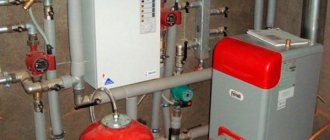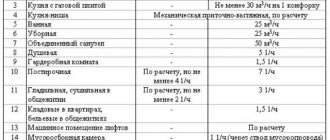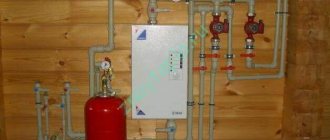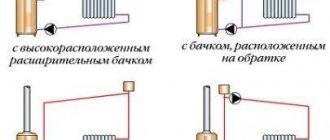You are the owner of a country house where main gas is not supplied, and the electrical networks are not designed for heavy loads, hence the allocated limit of 5 kW for all needs. Another variation on the theme: you are a rural resident of Ukraine, where the cost of blue fuel has jumped to 7.2 UAH. (0.3 USD) per 1 m³, so you cannot use it due to low income. There are other, more complex situations.
In this situation, you are faced with the task of providing heating for a private house without gas and electricity, preferably economically. Let's identify alternative heating methods and look at all the nuances associated with their implementation.
Method 1 - electric convectors
With the help of electric convectors it is possible to provide a cheap and efficient heating system. The electric convector is built on the principle of natural air circulation. Warm air moves upward from the heater, thus stimulating the movement of air inside the room and ensuring uniform heating. However, a convector is effective only in warm climates, when the temperature does not fall below 10-15 degrees.
pros
- No forced air blowing. Even in the cleanest home there are particulates that lie on surfaces. When warm air is artificially blown out of a heater, this dust becomes part of the air we breathe. Natural air circulation is not so active, so dust does not rise into the air.
- Small size with sufficient power. The heating elements of convectors heat up quickly, converting electricity into heat with an efficiency of up to 80%. In addition, there is a system of operation in different modes, as well as thermostats that allow operation not constantly, but only when the air temperature drops.
- Mobility, allowing you to move the convector around the room, to places with maximum cold flow.
- The possibility of creating a heating system exclusively using convectors or using them as part of a more complex heating system.
- The electric heating element does not heat up more than 100 degrees, and the body - 60 degrees. They have an increased level of protection from moisture, which allows the convector to be used in the kitchen and bathrooms.
Minuses
- The disadvantage of electric convectors is the installation of heaters in every room of the house.
- In addition, if you turn them on at the same time, there is a possibility of exceeding the permissible power limits.
However, the disadvantages can be turned into advantages by installing a relay for turning on the heaters one by one. The relay will allow you to create a stable temperature in the house, reduce energy costs and remain within the permissible power limits. There is another argument in favor of a system of convectors - they will not all fail at once. Replacing one or two appliances without losing heat is not difficult.
The photo shows an electric convector from Nobo, Norway
Solid fuel stove for temporary or backup heating of a country house
A story about temporary heating systems would not be complete without mentioning solid fuel stoves. We do not consider stone ovens as requiring large financial costs, preparing the base, pouring the foundation, etc. Let's give an example of a well-proven temporary solution for heating a country house using the example of a solid fuel stove.
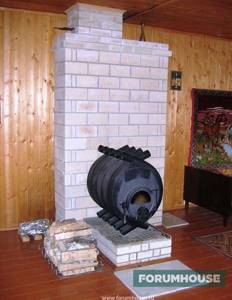
Konstantin FORUMHOUSE user
I have heard only positive reviews about these stoves. They work on the principle of conventional convection, have high efficiency, and are not difficult to operate. This is a good “country” option.
Traks FORUMHOUSE User
My stove is designed to heat an area of 200 square meters. m, but I only heat 70 sq. m. In my opinion, this stove is well suited for quickly warming up a room, but I do not recommend placing it in the bedroom. It is also very sensitive to the height and cleanliness of the chimney.
According to a portal participant with the nickname rodinad, the stove heated a room with a volume of 50 cubic meters. m from -7 °C to + 15 °C in 1 hour. If the oven is properly heated, the temperature can be increased to + 40 °C. At night, thick logs are thrown into the oven, and it is “driven” into smoldering mode to maintain the temperature until the morning.
Gary FORUMHOUSE User
I have been using this stove for a long time and am happy with everything. Among the disadvantages, I note the release of tar on the roof and the accumulation of deposits in the chimney, which can periodically ignite. In frosts of -25 °C, the stove warms up the house to + 18 °C in 4-5 hours, then we turn off everything, and on one load the stove works for 10 to 12 hours, then cools down for another hour. Compared to our neighbors who have other types of stoves, our wood consumption is about 1.5 times less. If there is no gas, and heating with diesel fuel is expensive, then I think this is the best option.
Our article contains recommendations for installing a sandwich chimney.
Method 2 - tubular electric heaters
They transfer heat from a tubular electric heater to a liquid-based coolant. Typically, water and oil are used as a coolant, and sometimes antifreeze. The design principle of heaters is the same as that of electric kettles, which is why they are also called heaters and oil radiators. In fact, it is a boiler placed in a vessel with water. The efficiency of such devices is quite high, and heat loss for heating is minimal.
pros
- The undoubted advantages of tubular heaters include their safety, operational reliability and versatility of use.
- Can be used in both gaseous and liquid media.
- Not explosive, and not afraid of vibrations and shocks.
- Tubular heaters are available in a variety of design solutions, which allows you to economically heat a private home with electricity without disturbing the aesthetics of the interior.
Minuses
Heating heating elements have a high cost due to the expensive metals that are used in production. Since scale forms on the pipes, it is necessary to take care of the quality of the water.
A tubular radiator is a thin-walled metal tube with a spiral inside, so if you do not need particularly high temperatures, then you need to take a heater with carbon steel tubes. If the device must produce a consistently high temperature or operate in an aggressive environment, then you need to take a device made of stainless steel.
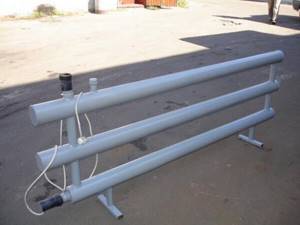
The photo shows a tubular electric heater made by yourself
Liquefied gas
In terms of cost per kilowatt of energy, liquefied gas ranks third.
There are different ways to deliver and store it, but the smaller the volume, the more expensive the final price. Therefore, a gas holder is needed for a permanent home, and for a small dacha, which is rarely visited in cold weather, you can get by with several 50-liter cylinders. When using a gas holder, the price of a kilowatt of heat from burning liquefied gas is 2.3-2.5 rubles, the use of cylinders raises the bar by 50 kopecks.
You can also heat yourself in different ways.
The simplest system is direct combustion of gas to produce heat without heating the intermediate coolant, pipework and radiators. For this purpose, gas convectors and infrared heaters are used. Their operating principle and design are different, but they have one thing in common - availability of equipment, compactness and operation from bottled gas. The disadvantage is the power limitation and heating of only one room. For example, infrared and catalytic gas heaters from AYGAZ have a maximum power of 6.2 kW.
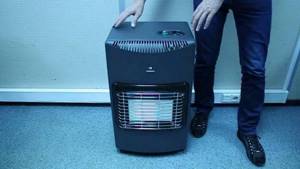
With such a compact infrared heater you can heat up to 40 m2 Source vps-region.ru
On a note! You can get professional advice on autonomous gasification of a private home directly from specialists
The gas tank allows you to build a full-fledged autonomous water heating system, and the frequency of refilling depends on the volume of the container, heating area and operating mode. In terms of ease of operation and maintenance, the system ranks second after electric heating. But it requires significant initial investment for the purchase of a gas tank, its installation (usually underground) and the laying of communications (pipes for connection to the boiler and electrical cable for the tank heating system).
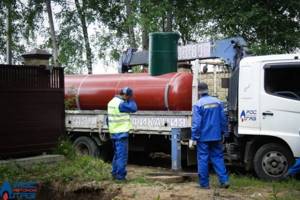
Another difficulty for a gas tank is choosing a location. It should be located close enough to the house and be accessible for gas refilling Source rosavtonomgaz.ru
Method 4 - electric boiler with heating element
The popularity of electric boilers is determined by their safety, low cost and reliability. Most consumers opt for heating element boilers - they are much cheaper than electrode and induction boilers, and they are easy to maintain.
However, due to the use of a thermoelectric heater (TEH), such heating cannot be called the most economical. In addition, before purchasing, I recommend checking the operating mode of the local electrical networks - perhaps the networks will not cope with the load you need and the purchase will be in vain.
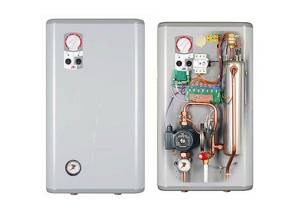
The photo shows an electric boiler KOSPEL, Poland
Operating principle of the heating system
People have always tried to get the heat emanating from the bowels of the earth. Thanks to the advent of geothermal heating, this became possible.
In the center of the earth there is magma, which warms the earth. Due to the presence of the top layer of soil, it does not cool. It was enough to learn how to use such heat to open an alternative source of heat. With its proper use, it will be possible to solve the problem of heat supply of any country houses.
Many people find the operating principle of a geothermal heat pump quite complex. In fact, it is enough to understand the features of heating from the ground. The operation of the system is possible due to the presence of an external circuit. performing the functions of a heat exchanger. It is located in water or underground. Inside this element there is water or any other liquid that absorbs heat. The coolant enters the geothermal pump, which accumulates heat. This equipment distributes the received energy throughout the entire internal circuit.
It is worth noting that such heat pumps correspond to standard sizes, but their performance turns out to be really high.
Method 5 - induction boiler
An induction boiler is a transformer with two types of winding. The resulting eddy currents follow the short-circuited loop, which is the boiler body. The secondary winding receives energy, which is converted into heat, heating the coolant.
Induction boilers heat your home quickly, can operate at low voltage, and have no parts that can fail. The efficiency of such a boiler is almost 100% and does not depend on the service life.
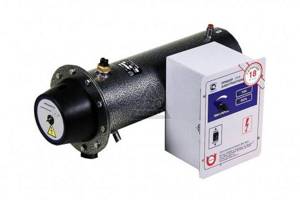
The photo shows an induction boiler EPO Evan 9.5 kW, Russia
Articles on the topic
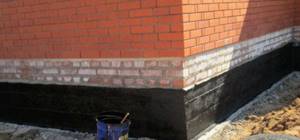
Waterproofing a brick plinth - horizontal, vertical, instructions, advice from masons
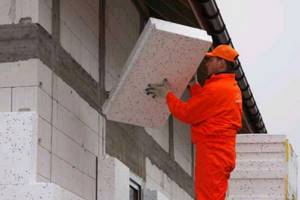
Insulating a house made of sand-lime brick - stages of work, instructions, advice from masons
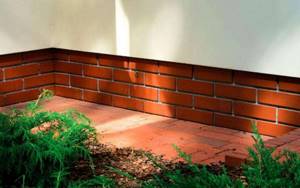
How to lay a foundation with bricks - stages of work, instructions, advice from masons

Skirting on a brick wall - is it necessary, how to fasten it, instructions, advice from masons
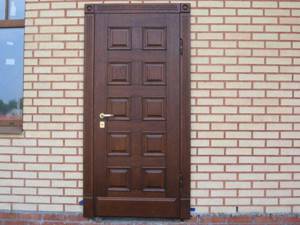
How to install a door in a brick house - options, installation, instructions, advice from masons

Dew point in a brick house - why it is calculated, instructions, advice from masons
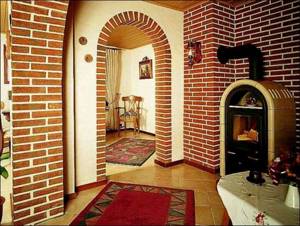
How to decorate an arch with decorative bricks - stages of work, instructions, advice from masons
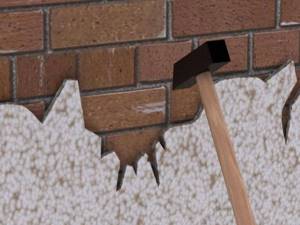
Preparing a brick surface for plastering - rules, instructions, advice from masons
Reviews ()
Method 6 - electrode boiler
Inside the electrode boiler there are electrodes, which act as a heating element. When current passes through a liquid, heat is generated. This means that in electrode boilers there is no actual heating element on which scale could form. The absence of scale will greatly facilitate operation.
Electrode boilers are highly reliable and operate much longer than tubular heaters. In addition, they are small in size, which is very convenient for a small residential building. The disadvantages include high requirements for the liquid used as a coolant. Water must undergo special treatment. Often, antifreeze generally must be exclusive - from the device developer.
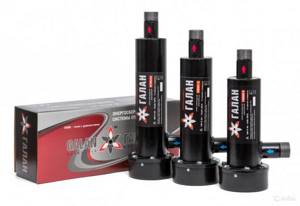
The photo shows an electrode boiler Galan, Russia
Method 7 - infrared heaters (the most economical)
Infrared heaters are considered the most economical of all types of electric heaters. They do not need heating elements and water pipes. Infrared heaters heat objects, not the room. Then the heated objects heat up the air. If an electric boiler can be compared to a kettle, then an infrared boiler can be compared to a microwave oven.
Infrared panels are especially popular. They are installed on the ceiling or walls of residential and industrial premises. Since the heating area is increased, the room becomes warmer faster than usual. Such a panel can be used as an independent heating source or as an addition to an existing system. An infrared heater goes well with electrode boilers. For example, an infrared heater can only be turned on in spring and autumn, when it is too early to turn on the main heating, or when it suddenly gets cold outside.

Pictured is a GROHE infrared panel, Germany
Option #5
Installation of a solid fuel stove is gaining popularity due to rising energy prices. The finished metal structure requires, in addition to fuel, the installation of an outlet where combustion products exit the combustion chamber. Subsequently, after finishing the finishing work, this channel can be used for a fireplace or ventilation. The only disadvantage of this method of heating an unfinished house is the regular maintenance of the stove. Even compressed briquettes require 1-2 single loadings, so it cannot be done without human intervention.
conclusions
- It is generally accepted that heating a house with electricity is not cheap. This is certainly true if we mean only payment according to tariffs. However, to the price of heating you need to add the cost of the equipment, as well as the costs of its maintenance and repair.
- If you compare bills for electricity, firewood, coal, pipes, boilers and other equipment, you can come to the conclusion that private heating with electricity is cheaper than solid-state boilers, stoves and other systems alternative to gas heating.
- In addition to money, there is another argument in favor of electric heating - it saves time: turn it on, leave and forget. The only downside is a sudden power outage.
Below, watch a video about how we managed to create cheap heating with electricity for a large private house.
Solid fuel
Not so long ago, solid fuel had no competitors. At first, firewood, and then coal, were the main types. Of course, they also burned peat, straw and even dung, but, as now, it was “local” fuel that was not widely used.
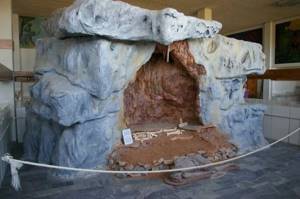
The primitive hearth in the cave is very reminiscent of a classic fireplace Source cottage.ru
With the beginning of the “gas era,” heating, firewood and coal faded into the background, but still remain in demand. Moreover, their prospects are “rosy”, since there are much more proven reserves of coal than gas, and firewood and “wood” fuel are renewable energy sources. The only modern difference is that previously only stoves or fireplaces were used to heat a house, but now a boiler is considered the main source of heat. Although there are exceptions.
They are still found today, especially when it comes to a small country house or dacha. The main advantage is absolute energy independence. Therefore, they are used when it is necessary to provide heating for a private home without gas or electricity.
Depending on their purpose, stoves can be either heating or heating-cooking. The first option includes a Russian stove and a Swedish stove, the second - a Dutch oven and a classic fireplace.

Heating and cooking stove Source bioenerga.gr
Their effectiveness largely depends on the design of the chimney system, of which there are three types:
- Straight-through. The chimney has a minimum number of bends in the direction from the firebox to the pipe. This category includes classic open-hearth fireplaces and Russian stoves. The radiator of heat is the body and part of the chimney that runs indoors or inside the wall. By the way, thanks to its special design and massiveness, the Russian stove is considered one of the most efficient. And a traditional fireplace has the lowest efficiency. And in modern realities it is more of a decoration or a means of relaxation while contemplating an open flame than a full-fledged heater.
- Duct. Combustion products are removed using a system of channels passing inside the furnace body, which not only emits, but also accumulates heat. The “Dutch” belongs to this type. It, like a Russian stove, takes a long time to warm up, but also takes a long time to cool down.
- Bell bells. Hot gases first rise into the “hood”, where they give up some of the heat, cool, fall along the walls of the hood and are drawn out into the chimney through the “hood”.
In addition to non-volatility, the advantage of classic stoves is their “omnivorousness” in relation to solid fuel. Firewood, coal, peat, briquettes - everything that can be put in the firebox with your hands and set on fire. Moreover, unpretentiousness extends to the ash content of coal and the moisture content of firewood.
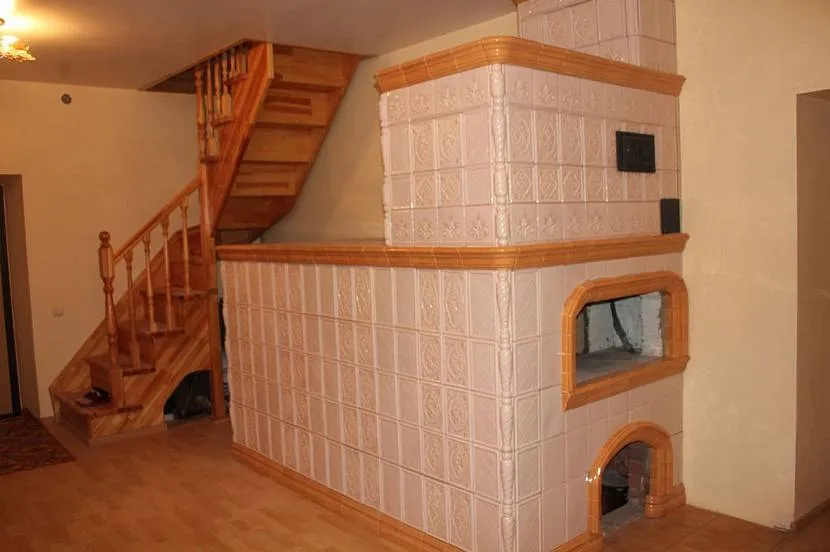
The Russian stove is still relevant and can heat several rooms on two levels Source yandex.uz
The disadvantages are no less significant than the advantages:
- radiation type of transfer of thermal energy - one stove heats a house where the entire living area is contained in one or two adjacent rooms;
- labor-intensive maintenance - frequent refilling of fuel and cleaning;
- low efficiency (efficiency on average about 20%) - the fuel does not burn out completely and most of the heat “flies down the chimney” along with the smoke;
- a complex hand-made design that can only be performed by an experienced craftsman.
Modern solid fuel boilers and factory fireplace inserts do not have these disadvantages.
See also: Catalog of companies that specialize in insulating country houses.
Solid fuel boilers
Another not the worst option than heating the house. Modern solid fuel boilers have an efficiency of 80-95%. That is, the best examples of operating efficiency are at the level of gas boilers, and only three economic factors “throw them back” into second place:
- higher cost of coolant per kilowatt of thermal energy;
- higher price of equipment;
- “there are” maintenance costs (costs of transport, fuel storage and disposal of solid residues).
If we talk about cost, then in the Moscow region, heating with wood is approximately one and a half times more expensive than gas - about 90 kopecks. per kilowatt versus 53 kopecks. (at tariffs for natural gas for the second half of 2021, subject to the availability of metering devices).
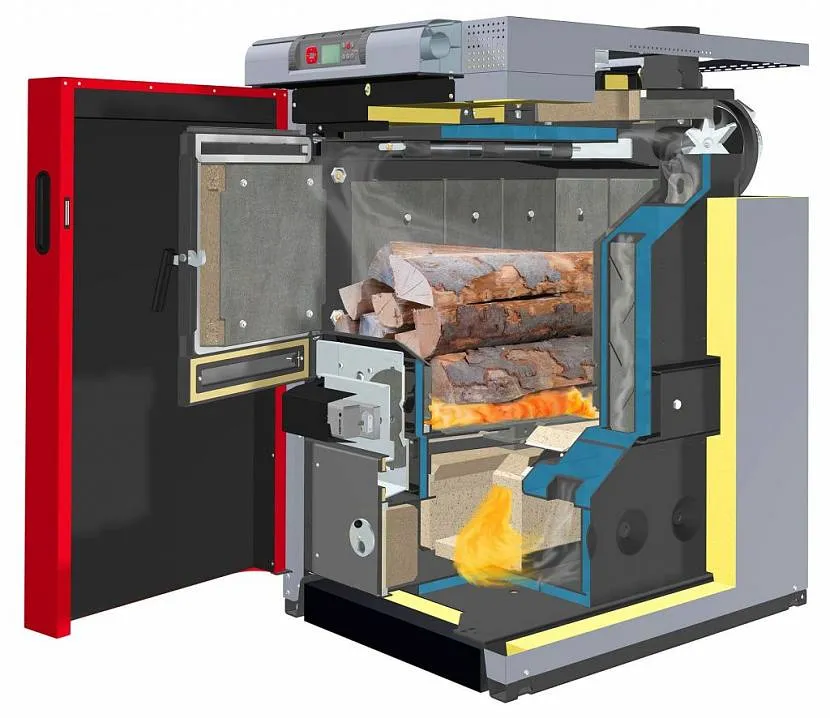
Pyrolysis boilers have the highest efficiency - the wood in them burns almost completely, with minimal “solid” residue Source pogreb-podval.ru
The use of fuel pellets increases the cost per kilowatt to 1.3-1.4 rubles. and is almost comparable in price when using coal, but still 15-20% cheaper than heating with anthracite. But there are nuances here.
If the task is how to heat a house cheaply without gas, then long-burning wood boilers or pyrolysis (gas generator) models best meet this condition. The only drawback is that laying firewood is done manually and it is impossible to automate this process. Although this should be done infrequently - 1-2 times a day. Also keep in mind that you need to carefully check the information about the so-called “magic” long-burning wood-burning boilers.
Pellet or coal boilers are available with automatic loading of fuel from the bunker. And although the bunker also needs to be loaded manually, it is much larger than the volume of the firebox. A regular boiler model with a standard hopper with a capacity of 1 m³ can operate continuously from three days to a week, and with an enlarged hopper - up to 12 days (taking into account high-quality insulation of the house and low heat loss). And when it is not possible to frequently load fuel, then these boilers are the best option (if you do not take into account higher prices for equipment).

Long-burning solid fuel boilers with a large-capacity hopper do not require daily maintenance from the owners Source kaminyn.ru
Note. There are even automatic modular coal boilers with a bunker volume of up to 14 m3, their own crusher, auger fuel supply to the firebox and automatic soot removal into their own bunker - practically a mini-boiler room for a private home. Moreover, this is a domestic development and the cost of the equipment is also “domestic”.
Fireplace inserts
Modern fireplace inserts, fireplace stoves and stoves do not differ in operating principle from solid fuel boilers. They also have the function of long burning and secondary combustion. Their efficiency differs from gas generator boilers by only 5-10%, which is at least four times higher than that of classic fireplaces with an open firebox.
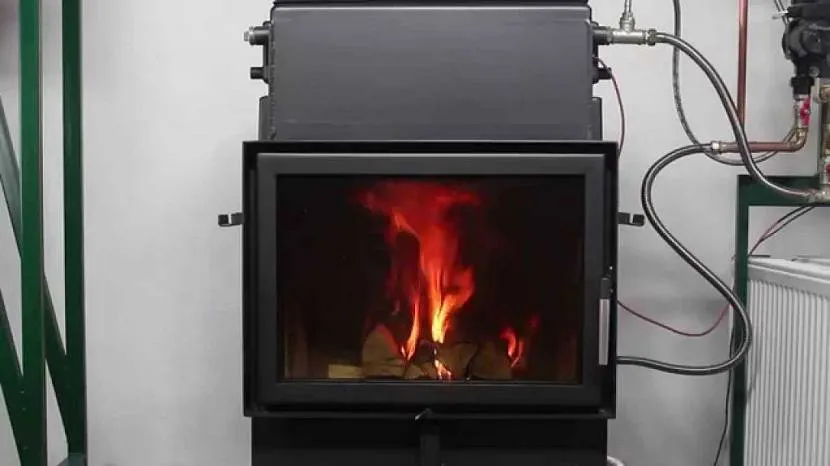
Demonstration model of a closed fireplace insert with a water circuit Source bestpechi.ru
